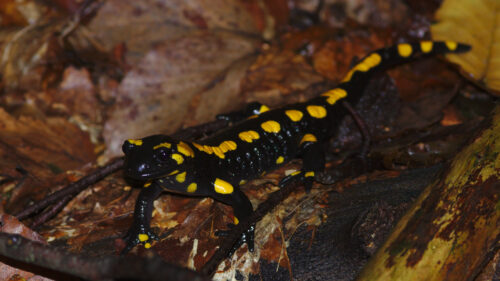Image courtesy of Flickr.
According to all known laws of evolution, there is no way that salamanders should be able to exist. At first glance, these creatures seem like marvels of evolution with regenerative abilities and other unique adaptations that protect them from predators. However, upon closer inspection, their very existence seems to break all rules. Their hearts are practically hollow, with muscle walls as thin as a single cell. Their cells are oversized, sometimes hundreds of times larger than those of humans. Trying to build such a small animal with such large cells is like trying to make a detailed sketch with a king-size Sharpie. Rather than being evolutionary marvels, salamanders seem to be on the verge of death at all times.
Perhaps more surprising, though, is that many salamanders seem to be barely born. They normally start their lives as aquatic larvae and later metamorphose into terrestrial adults. However, several species have lost their ability to metamorphose, remaining confined to a half-larval state for the entirety of their lives, never losing their gills or developing strong limbs. Their bones never fully harden, remaining soft cartilage instead. Even their brains are embryonic, with less cell differentiation than their amphibious relatives.
So how are they still around?
The secret to this anatomical curiosity lies where most biological secrets lie–within the genome. However, its peculiar phenotypes may not come from specific genes. Instead, they are a product of the quantity of DNA present.
Salamanders contain some of the largest genomes of any animal, with some species carrying 38 times as much DNA as humans. Their slow development can be explained by the fact that all their “extra” DNA drastically increases the time it takes to transcribe DNA to RNA. The size of the salamanders’ genome goes against the common notion that larger, more complex animals, like humans or primates, should carry larger genomes than simpler ones, like salamanders. So why are salamander genomes so large?
Scientists discovered that salamander genomes are riddled with sections of DNA called “selfish genetic elements.” These elements consist of short DNA segments, called transposons, which contain various genes that code for their own replication. Once copies of these transposons are produced, they insert themselves into different parts of the genome. Transposons can also affect the function of native genes, activating or deactivating them, potentially harming the host.
Transposons are found in most living things, including humans, but their density in salamanders is extremely unusual. Usually, transposons are deleted over time through random mutations, but it is believed that salamanders parse their genomes at a rate much slower than humans or other organisms, resulting in the accumulation of genetic material.
These rogue, selfish genetic elements appear to be a wrinkle in the laws of evolution that we are familiar with. Scientists are beginning to look at the genome itself as an ecosystem, with transposons acting as species within it to better understand their role. Under such a model, transposons adapt and change to maximize their prevalence in the genome. If a transposon’s location has a positive or neutral effect on the host, it will likely persist there, being passed down to future generations.
Usually, if the accumulation of transposons begins to have detrimental effects on a species, natural selection will pare down the genome. The persistence of the salamander’s large genome suggests that the downsides associated with it do not significantly affect them. As a result, this genetic process created a feedback loop where salamanders’ slowly growing genomes pushed them into the evolutionary niche that they occupy today.
Our knowledge of salamanders and transposons is altering our understanding of evolution. Not all changes to phenotypes are driven by evolutionary pressure or are beneficial to the organism. Rather than viewing DNA and organisms as inseparable, scientists are beginning to consider DNA as something that attempts to replicate itself through whatever means, without consideration for the overall well-being of its host.
Salamanders’ bloated genomes seem to have pushed it to the brink of extinction. Its mangled bones, flimsy heart, and underdeveloped body don’t make any sense.
The salamander, of course, lives anyways. Because salamanders don’t care what humans think is impossible.

